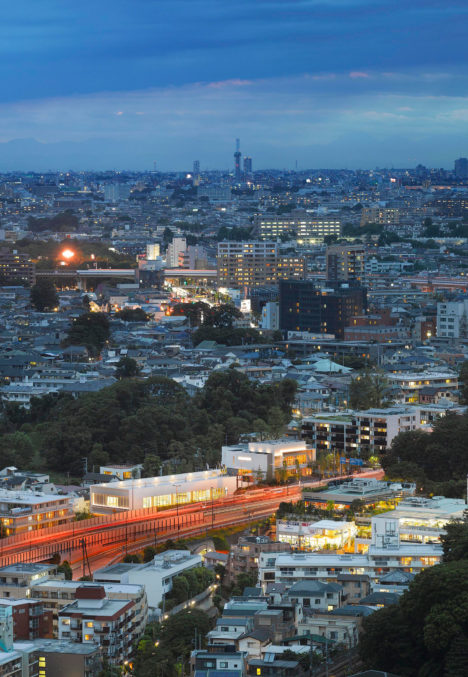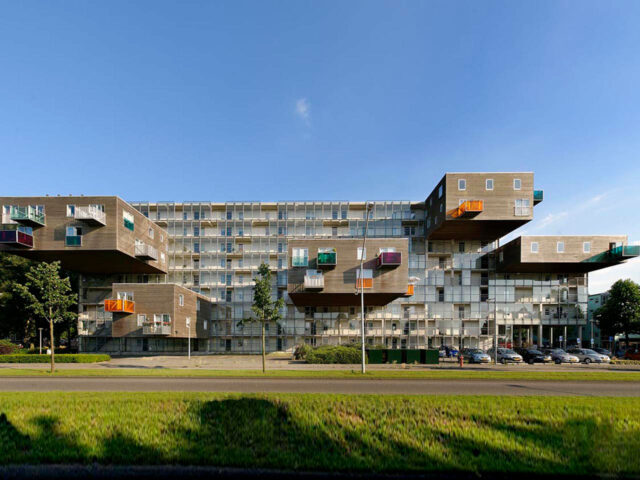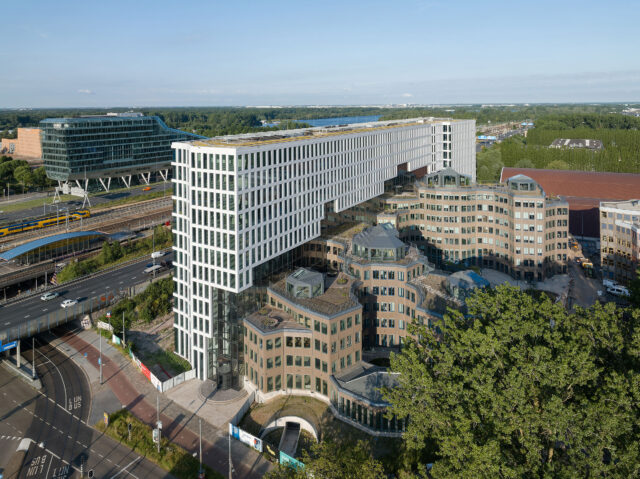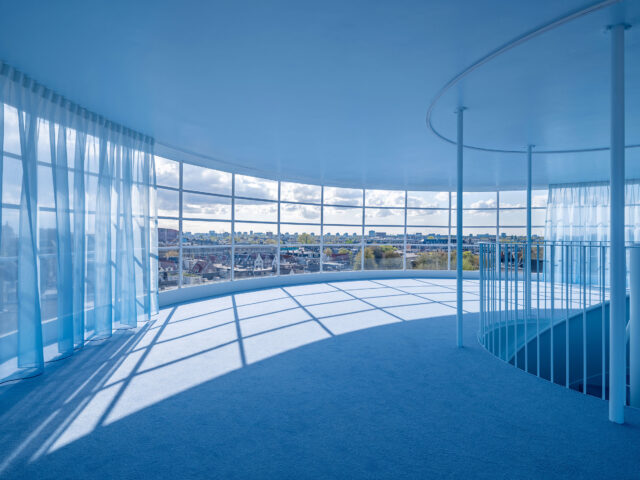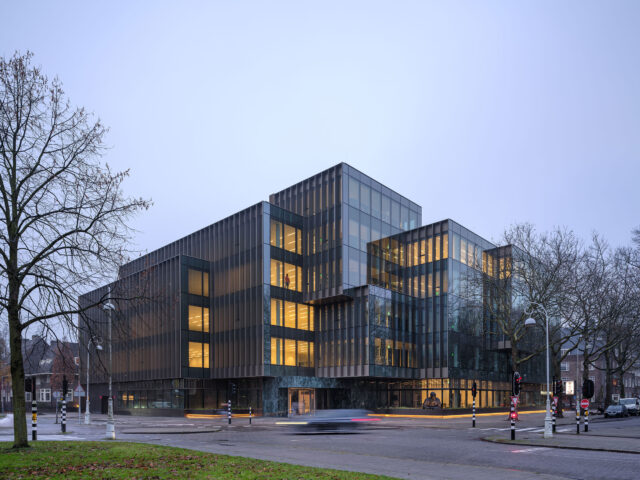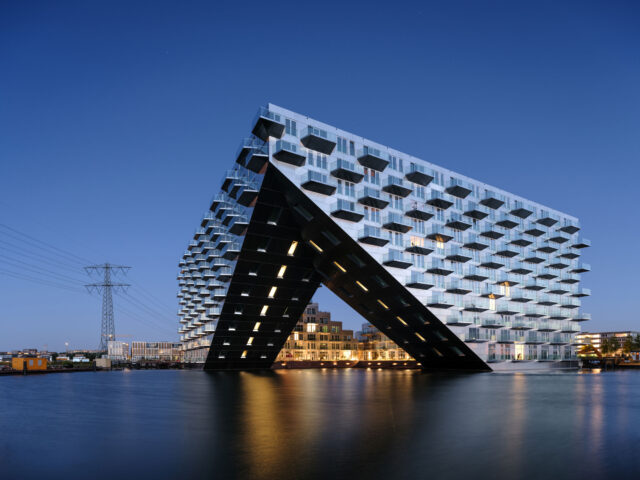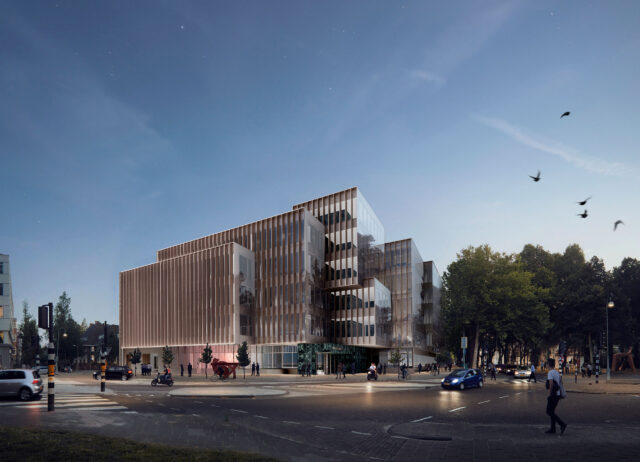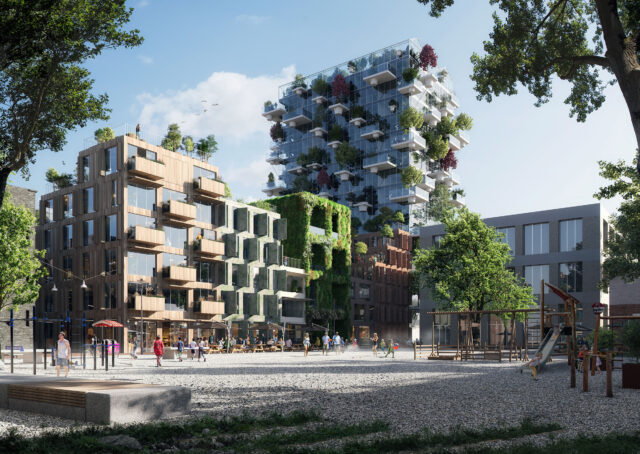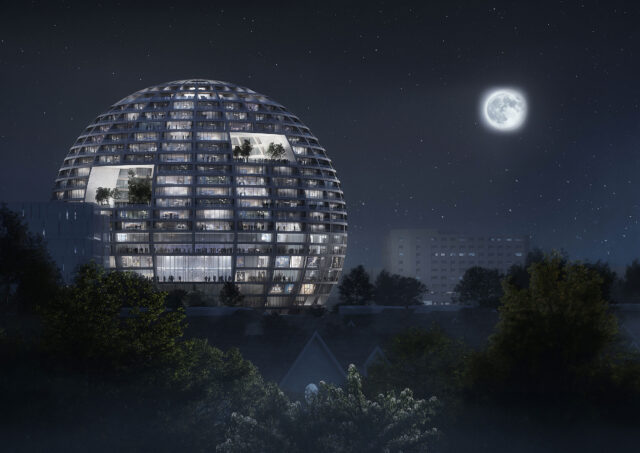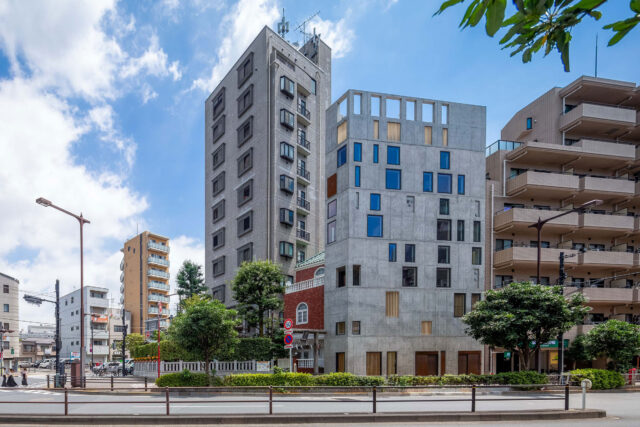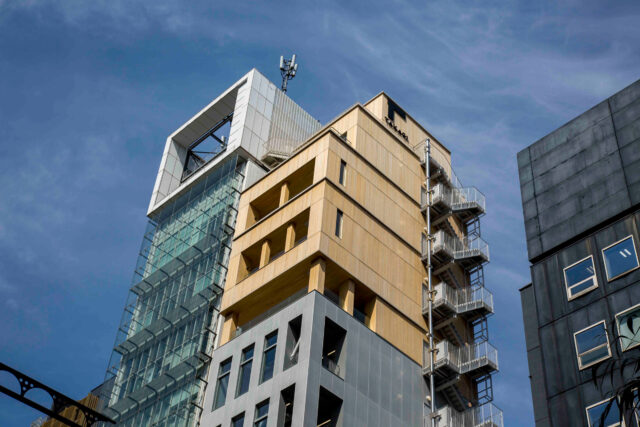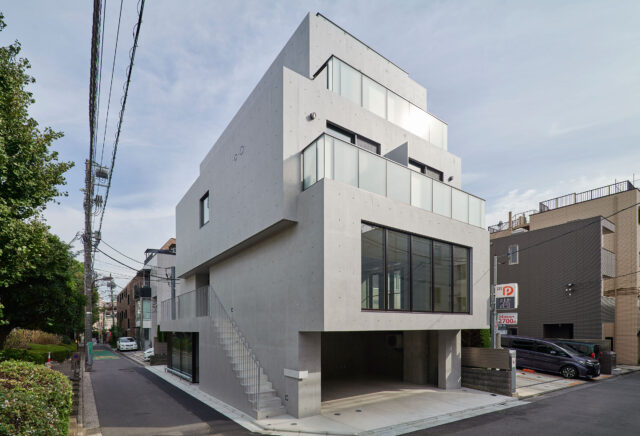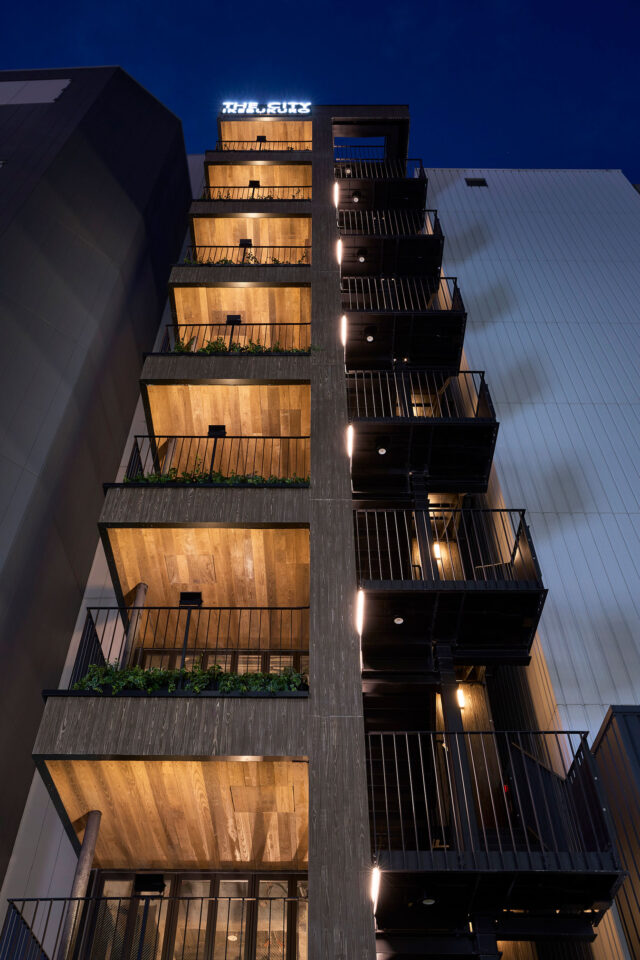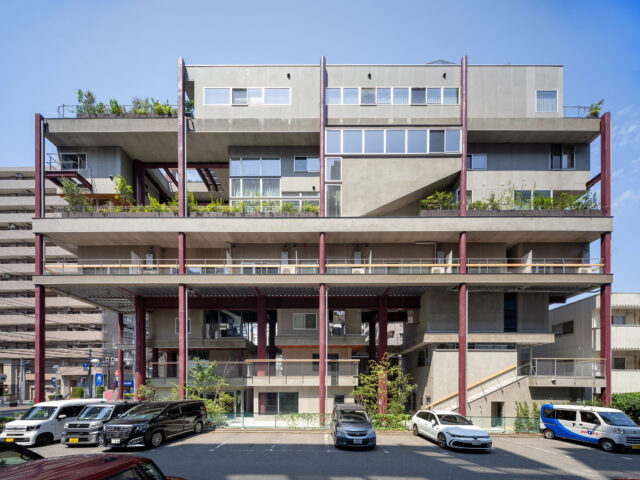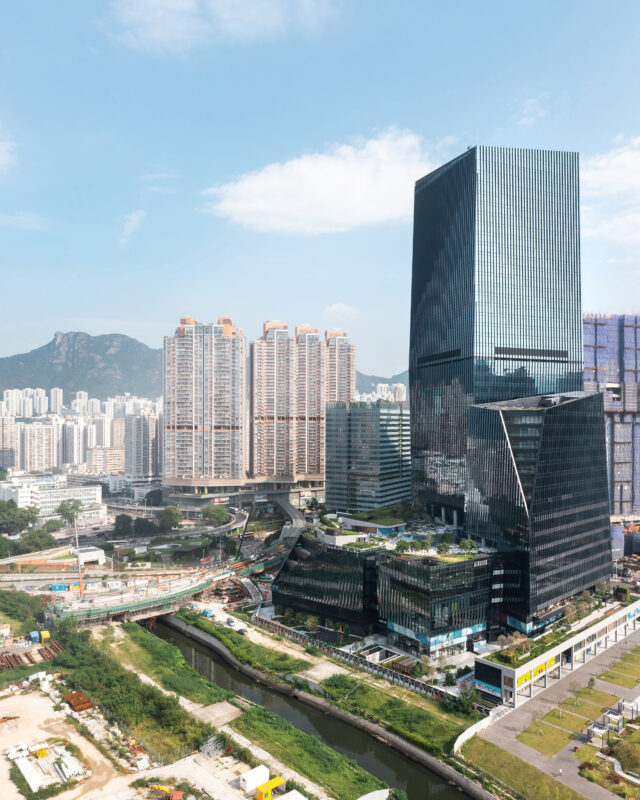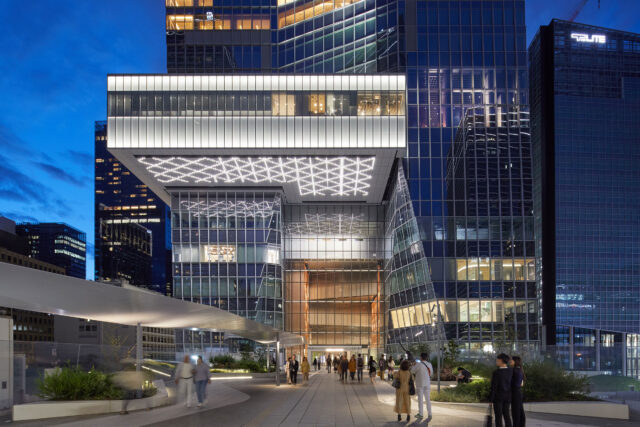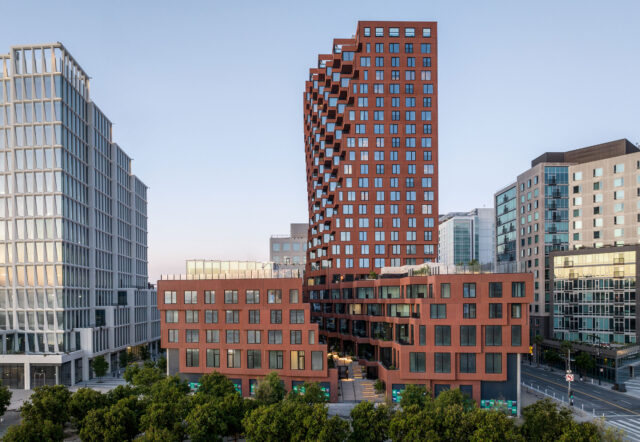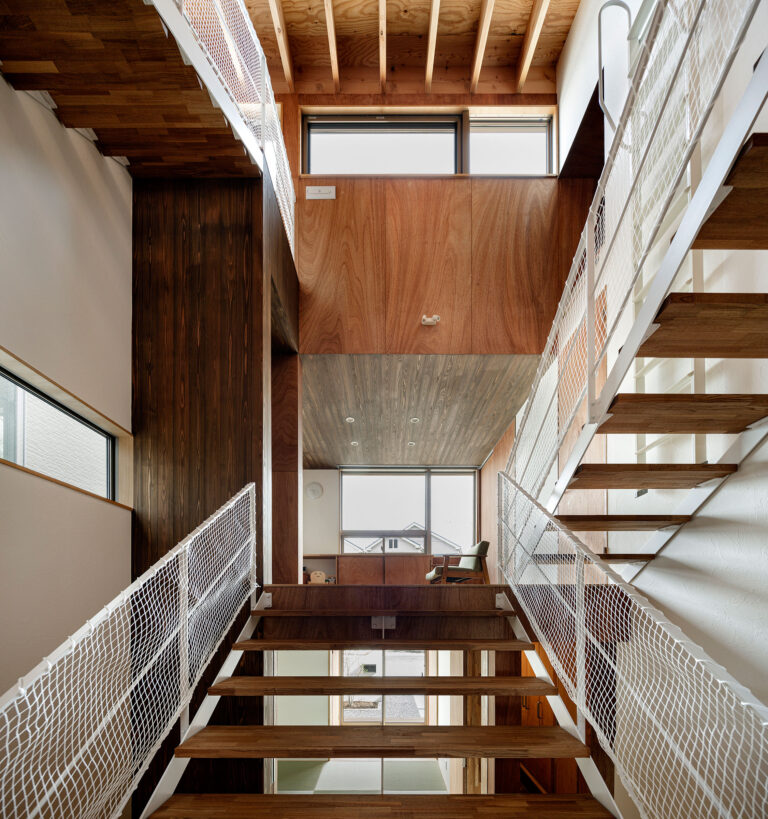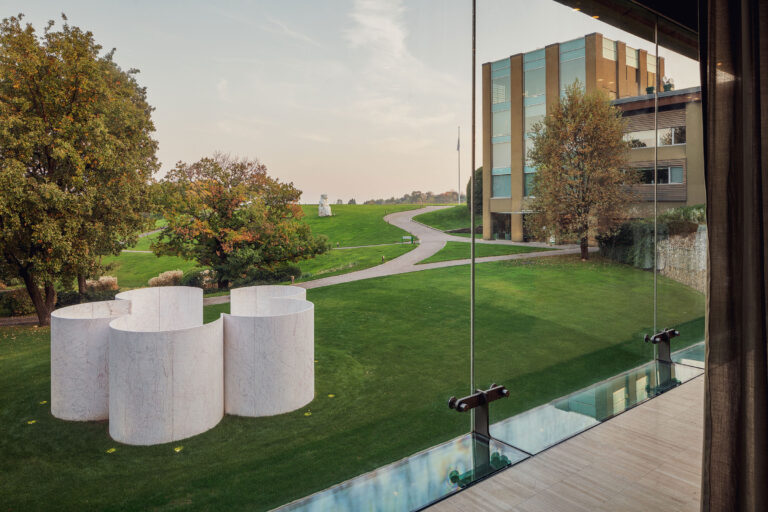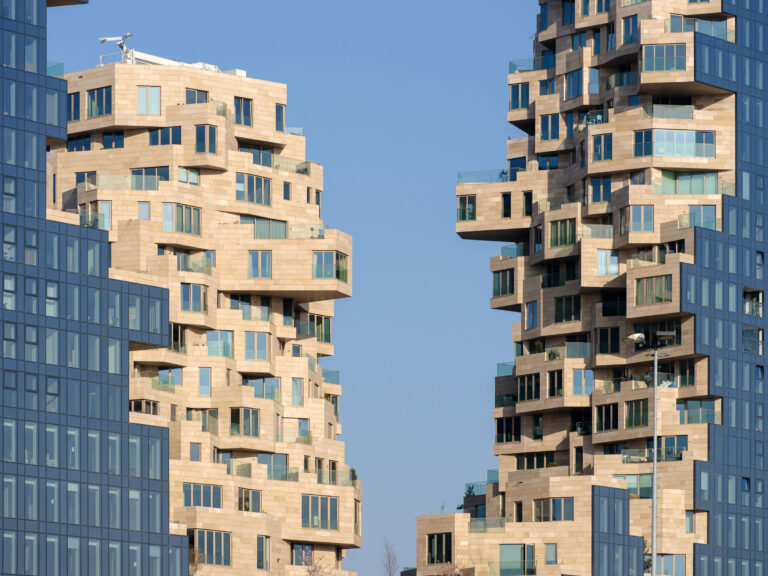
SHARE MVRDVによる、オランダの複合ビル「Valley」。オフィス街の居住・労働・商業の為の施設。地域に緑と人間の次元を取り戻す事を目指し、低層部に多様な植栽を配置した公共的空間を配置。専用デジタルツールを開発し採光眺望や割付等の決定等を合理的に進める




MVRDVが設計した、オランダ・アムステルダムの複合ビル「Valley」です。
オフィス街の居住・労働・商業の為の施設です。建築家は、地域に緑と人間の次元を取り戻す事を目指し、低層部に多様な植栽を配置した公共的空間を配置しました。また、専用デジタルツールを開発し採光眺望や割付等の決定等を合理的に進めました。
こちらはリリーステキストの翻訳です
「夢のイメージを建築化できる」MVRDVのアムステルダム「Valley」がオープン
MVRDVがデベロッパーEdgeのために設計した、地質学にヒントを得た植物で覆われたドラマチックな高層ビル「Valley」が、金曜日に正式にオープンしました。最近、Emporis Awardsで世界最高の新しい超高層ビルに認定された75,000㎡のビルは、67m、81m、100mの3つのタワーと壮大な片持ち梁のアパートメントでアムステルダムのZuidas地区で際立っています。このビルの特徴はいくつかあります。1つ目は、オフィス、ショップ、ケータリング、文化施設、アパートメントを1つの建物にまとめていること、2つ目は、他のズイダスの閉鎖的な建物と異なり、4階と5階のタワーの間を流れる緑の谷に、2つの外部石階段で誰でもアクセスできるようになっていることです。造園家ピエト・ウードルフの設計による広大な植栽には、約13,500本の若い植物、低木、樹木が植えられています。今後、これらの成熟が進めば、バレーはますます緑豊かな外観を持つようになり、このビルはより環境に優しい街のマニフェストとなることでしょう。
Valleyは、アムステルダム・ズィーダスの荒涼たるオフィス環境に、緑と人間の次元を取り戻そうとする試みです。この建物は、複数の顔を持っています。建物の外周には、ビジネス街の文脈に合った滑らかな鏡面ガラスのシェルがあります。このシェルの中においては、ガラスブロックが崩れ落ち、ごつごつした岩肌に自然石や緑が映し出されたかのような、まったく異なる魅力的な自然景観を実現しています。
3つのタワーからなる複合施設には、息を呑むような街の景色を楽しめる場所がいくつもあります。- マンションはもちろんのこと、特に、一番高いタワーの最上階にあるスカイバーは、1階にあるモルテーニのフラッグシップストアからアクセスすることができます。建物のレイアウトは、地下3階建ての駐車場の上に、低層7フロアをオフィス、9階以上をマンションとし、居住者、労働者、来訪者が混在するようになっています。建物の多くは一般に公開されています。街路から中央の渓谷までジグザグに伸びる公共的な歩道から、2階にある屋根付きの通りを形成するアトリウム「グロット」、そして間もなくオープンする若い科学者の育成の場「サピエンス・ラボ」まで、建物の多くが公開されています。グロットは2つの大きな天窓で外部とつながっており、その天窓は上の谷のレベルにある浅い水たまりを兼ねています。天然石の床、壁、天井は、谷やタワーの表面と同じ石を使っており、建物のすべてのパブリックエリアが同じ地層の一部と見なされていることを明確に示しています。
Valleyの設計と建設は、何百人ものデザイナー、エンジニア、建設業者、コンサルタント、そしてもちろんクライアントが持続的に関与することを必要とする、完全なオーダーメイドです。極めて複雑な形状は、細部のディテールにも特別なこだわりを求め、それはデザインコンセプトをより一層高めています。MVRDVのテクノロジー・エキスパートは、建物を完璧に仕上げるために、一連のカスタム・デジタル・ツールを作成しました。それは、すべてのアパートメントに十分な採光と眺望を確保するツールから、建物のファサードを飾る大小4万枚以上の石のタイルの一見ランダムなパターンを可能にするプログラムまでに及びます。198戸のアパートメントは、ハイリガー・アーキテクツが手がけたインテリアデザインによって、それぞれがユニークな間取りとなっています。また、タワーの奇抜なキャンティレバーは、コンクリートの建物にボルトで固定された11本の鋼鉄製の「スペシャル」を含む革新的なエンジニアリングによって可能となっており、全体の外観を次のレベルに引き上げています。
造園家ピエト・ウードルフは、風、日照、温度、メンテナンスなどの要素を考慮し、建物のそれぞれの場所に適した植物を選択するためのマトリックスを開発しました。例えば、低層階には主に樹木が、最上階には主に小さな植物が植えられています。合計で、271本以上の若い木や低木、約13,500本の小さな植物が自然石のプランターを占めており、220種類の植物が植えられています。今後数年で、緑が増え続け、設計チームが思い描いた緑豊かな外観に成熟していくことでしょう。このランドスケープの生物多様性は、バードボックスやバットボックス、様々なハチや昆虫のホテルによってさらにサポートされています。自動灌漑システムと「ファサードガーデナー」によって管理されるテラスの木々や植物は、ヴァレーに住む人々や働く人々の健康に良い影響を与えることでしょう。
Valleyは、サステナビリティ、テクノロジー、ヘルスの各分野の洞察を結集しています。エネルギー性能は現地の規制値より30%向上し、商業スペースはBREEAM-NL Excellent認証を取得、住宅エリアはオランダの測定ツールGPR Building Scale(エネルギー、環境、健康、使用の質、将来価値の5つのテーマで建物を採点)で10点中8点を獲得しています。オフィス空間には、IPベースのビルディングオートメーションシステムや、実際の使用状況のモニタリングと連動した各種センサーなど、最新のスマートテクノロジーが組み込まれています。
Valleyの建設には4年を要し、2022年末に最初の居住者と起業家が入居しています。先週金曜日、ビルのオーナーであるRJB Group of CompaniesとデベロッパーのEdgeが主催するオープニングセレモニーで、このプロジェクトはついに一般市民による全面入居の準備が整ったのです。
すでにこのビルの印象的なデザインは、オランダの新聞を中心に、メディアの注目と議論を集めています。「MVRDVはまたしても、夢のイメージを建築可能なものにしたのです」と、デ・フォルクスクラントのキルステン・ハンネマ記者は説明します。「日照、眺望、冷房負荷、騒音などの条件を入力する3Dソフトを使い、設計を合理化したのです。不規則な形状のファサードは、最終的に約10の異なる角度を持ち、天然石のクラッディングがパズルのように組み合わされています」
「ズイダスの石の砂漠の中のオアシス」とNRCハンデルスブラッド紙にベルナルド・ハルスマンは書いています。「Valleyがアムステルダム環状道路A10とブイテンフェルト地区の間に過去四半世紀にわたって建設されてきたすべてのタワーと異なるのは、垂直の森と片持ち梁の建物部分(そのうち11棟は浮遊するように見えるほど大きい)だけではありません。1階には飲食店やショップ、低層の7フロアにはオフィス、その上にはさまざまな形や大きさの198戸の高価な賃貸住宅があり、「Valley」は仕事、生活、娯楽が混在するズイダスで最初の建物です」
以下の写真はクリックで拡大します































































以下、建築家によるテキストです。
“Dream images can be made buildable”: MVRDV’s Valley in Amsterdam is open
Valley, the dramatic, geology-inspired, plant-covered high-rise designed by MVRDV for developer Edge, was officially opened in a ceremony on Friday. The 75,000-square-metre building, which was recently declared the world’s best new skyscraper by the Emporis Awards, stands out in Amsterdam’s Zuidas neighbourhood with its three towers of 67, 81, and 100 metres and its spectacular cantilevered apartments. The building distinguishes itself in several ways: firstly, it combines offices, shops, catering, cultural facilities, and apartments in one building; secondly, unlike the closed-off buildings elsewhere in the Zuidas, the green valley that winds between the towers on the fourth and fifth floors is accessible to everyone via two external stone staircases. The building’s extensive planting, designed by landscape architect Piet Oudolf, hosts approximately 13,500 young plants, shrubs, and trees. As these mature over the coming years, they will give Valley an increasingly green appearance, making the building a manifesto for a greener city.
Valley is an attempt to bring a green and human dimension back to the inhospitable office environment of Amsterdam Zuidas. It is a building with multiple faces; on the outer edges of the building is a shell of smooth mirrored glass, which fits the context of the business district. Inside this shell, the building has a completely different, more inviting natural appearance, as if the glass block has crumbled away to reveal craggy rock faces inside replete with natural stone and greenery.
Various locations throughout the three-tower complex offer breathtaking views of the city – the apartments, of course, but especially the sky bar at the top of the tallest tower, which visitors can access via the Molteni flagship store on the ground floor. The building’s layout is tailored to a mixture of residents, workers, and visitors: on top of the three-storey underground car park, offices occupy the lower seven floors, with apartments located on the eighth floor and up. Much of the building is open to the public: from the publicly accessible footpath that zig-zags up to the central valley from the street level, to the Grotto, an atrium that forms a covered street on the first floor where the Sapiens Lab – a breeding ground for young scientists – will soon open. The grotto is connected to the outside by two large skylights that double as shallow water pools in the valley level above, and its natural stone flooring, walls, and ceilings – the same stone used on the surfaces of the valley and towers – makes clear that all the public areas of the building are part of the same apparently geological formation.
The design and construction of Valley is utterly bespoke, requiring the sustained commitment of hundreds of designers, engineers, builders, consultants, and of course the client. The enormously complex shape required a special commitment to fine detailing that further enhances the design concept. MVRDV’s technology experts created a series of custom digital tools to perfect the building, from a tool that ensured every apartment had adequate light and views, to a programme that made possible the apparently random pattern of over 40,000 stone tiles of varying sizes that adorn the building’s façades. Each of the 198 apartments has a unique floorplan, made possible by the interior designs by Heyligers Architects. And the outlandish cantilevers of the towers are possible thanks to innovative engineering, including eleven steel “specials” bolted to the concrete building that take the overall appearance to the next level.
Landscape architect Piet Oudolf developed a matrix to select the right plants for each location in the building, taking into account factors such as wind, sunlight, temperature, and maintenance. Trees, for example, are largely found on the lower floors, while the uppermost levels mainly support small plants. In total, more than 271 young trees and shrubs and approximately 13,500 smaller plants occupy the natural stone planters, representing 220 different plant species. In the coming years, the building will mature into the lush appearance of the design team’s vision as the greenery continues to grow. The biodiversity of this landscape is further supported by bird- and bat boxes as well as various bee and insect hotels. Maintained using an automatic irrigation system and by “façade gardeners”, the trees and plants on the terraces will positively affect the well-being of people living and working in Valley.
Valley combines insights in the field of sustainability, technology, and health. The building’s energy performance is 30% better than local regulations require, it has received BREEAM-NL Excellent certification for the commercial spaces, and the residential area scored an 8 out of 10 on the GPR Building Scale, a Dutch measurement tool that scores buildings across five themes of energy, environment, health, quality of use, and future value. The latest smart technologies are integrated in the office spaces, including IP-based Building Automation Systems and various sensors linked to monitoring actual usage.
The construction of Valley took four years, with the first residents and entrepreneurs moving into the building at the end of 2021. With the opening ceremony hosted last Friday by the building’s owner RJB Group of Companies and developer Edge, the project is finally ready to be occupied fully by the public.
Already the building’s striking design has attracted media attention and debate, especially in the Dutch press. “Once again, MVRDV shows that dream images can be made buildable,” explains Kirsten Hannema for de Volkskrant. “Using 3D software, in which the architects entered requirements with regard to daylight, view, cooling load and noise exposure, they ‘rationalised’ the design. The irregularly shaped facades eventually have about ten different angles, with the natural stone cladding fitted together like a puzzle.”
“An oasis in the stone desert on the Zuidas,” writes Bernard Hulsman in the NRC Handelsblad. “It is not only because of the vertical forest and the cantilevered building parts, eleven of which are so large that they seem to float away, that Valley differs from all the towers that have been built over the past quarter of a century between the Amsterdam ring road A10 and the Buitenveldert district. With catering establishments and shops on the ground floor, offices on the bottom seven floors and, above that, 198 expensive rental homes in many shapes and sizes, Valley is the first building in the Zuidas where working, living, and entertainment are mixed.”
■建築概要
Project Name: Valley
Location: Amsterdam, The Netherlands
Year: 2015-2022
Client: EDGE
Size & Programme: 75,000m2 mixed-use (residential, offices, cultural, retail, and parking)
Sustainability certification: BREEAM-NL Excellent (commercial spaces)
───
Credits
Architect: MVRDV
Principal in charge: Winy Maas
Partner: Jeroen Zuidgeest
Director: Gideon Maasland
Competition: Anton Wubben, Luca Moscelli, Sanne van Manen, Elien Deceuninck, Marco Gazzola, Jack Penford Baker, Brygida Zawadzka, Francis Liesting, Annette Lam, Hannah Knudsen
Design Team: Gijs Rikken and Gideon Maasland with Guido Boeters, Wietse Elswijk, Saimon Gomez Idiakez, Rik Lambers, Javier Lopez-Menchero, Sanne van Manen, Stephanie McNamara, Thijs van Oostrum, Frank Smit, Boudewijn Thomas, Maria Vasiloglou, Laurens Veth, Cas Esbach, Mark van Wasbeek, Olesya Vodenicharska Diagrams and Drawings: ©MVRDV
Copyright: MVRDV Winy Maas, Jacob van Rijs, Nathalie de Vries
───
Partners
Building Owner: RJB Group of Companies
Contractor: G&S Bouw B.V., Boele & Van Eesteren B.V.
Landscape Design: Piet Oudolf, DeltaVorm Groep
Interior design: Heyligers Architects
Engineering: Inbo
Cost Calculator: BBN adviseurs
Structural Engineer: Van Rossum Raadgevende Ingenieurs
Installations: Deerns, DWA
Building Physics and Fire Safety: DGMR
Parametric Design Volume: ARUP
Real Estate Consultant: CBRE, Heeren Makelaars
Images: Vero Visuals
Graphic Design: PlusOne
Model: made by mistake
Photography: Ossip van Duivenbode

